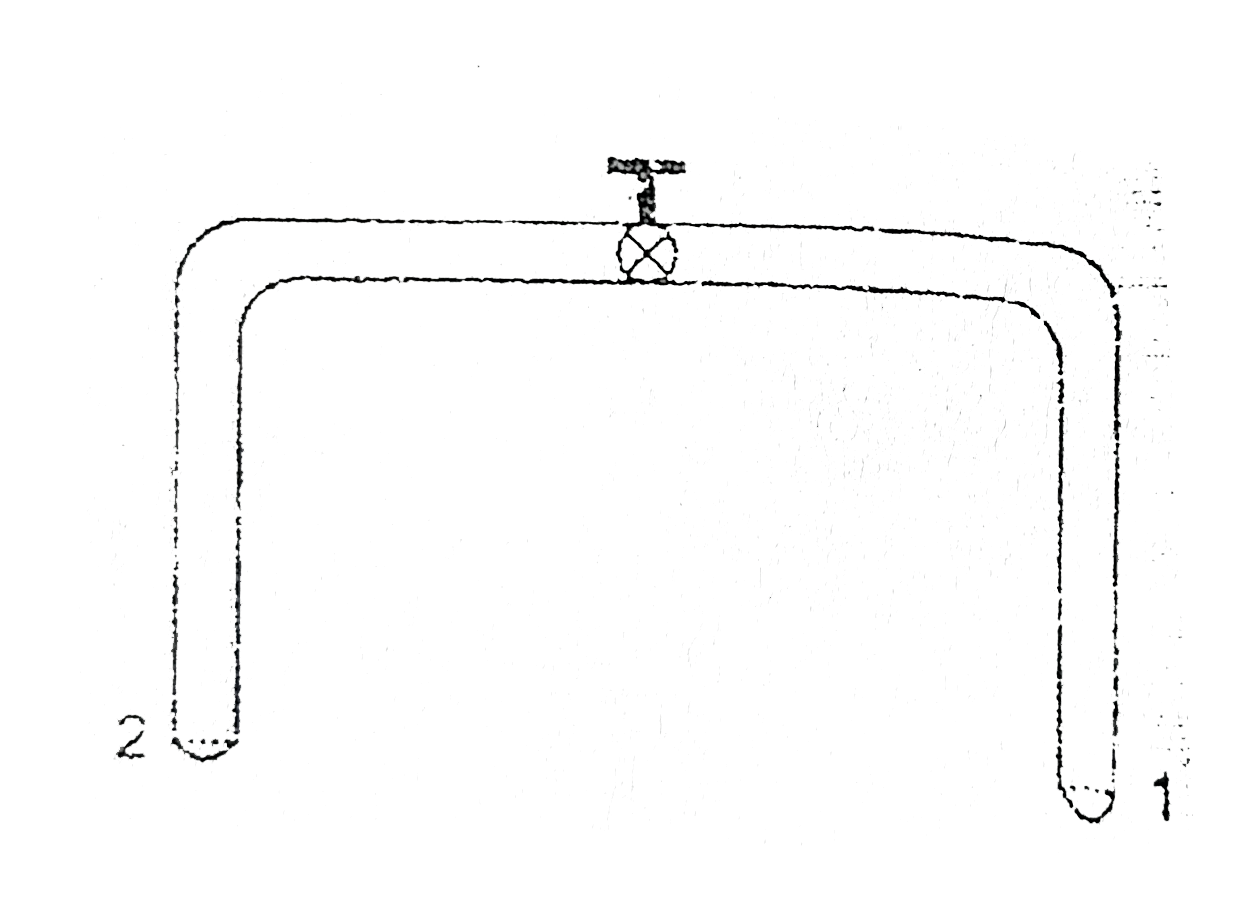A glass tube of uniform internal radius (r) has a valve separating the two identical ends. Initially, the valve is in a tightly closed position. End 1 has a hemispherical soap bubble of radius r. End 2 has sub-hemispherical soap bubble as shown in figure. Just after opening the valve.

air form end 1 flows towards end 2, No change in the volume of the soap bubbles
air from end 1 flows towards end 2. Volume of the soap bubble at end 1 decreases
no change occurs
air from end 2 flows towars end 1 .Volume of the soap bubble at end 1 increases
The correct Answer is:B
Excess pressure in a soap bubble , dP=4TrordP∝1r
The radius of the hemispherical soap bubble at the end (1) is less than that of the sub - hemispherical soap bubble at the end (2) . Excess pressure at the end 1 is more than that at the end 2 .
∴ Air from end 1 will flow the end 1 to end 2 and hence the volume of the soap bubble at the ebd (1) will decrease . This is option (b) .
Topper's Solved these Questions
- SURFACE TENSION Book:MARVEL PUBLICATIONChapter:SURFACE TENSION Exercise:MULTIPLE CHOICE QUESTIONS . (GRAPHICAL MCQS)
Explore 3 Videos
- SURFACE TENSION Book:MARVEL PUBLICATIONChapter:SURFACE TENSION Exercise:MULTIPLE CHOICE QUESTIONS . (MCQ FROM PREVIOUS EXAMS)
Explore 7 Videos
- SURFACE TENSION Book:MARVEL PUBLICATIONChapter:SURFACE TENSION Exercise:MULTIPLE CHOICE QUESTIONS . (STANDARD LEVEL)
Explore 55 Videos
- STATIONARY WAVESBook:MARVEL PUBLICATIONChapter:STATIONARY WAVESExercise:TEST YOUR GRASP-8
Explore 20 Videos
- WAVE MOTIONBook:MARVEL PUBLICATIONChapter:WAVE MOTIONExercise:Test your grasp
Explore 15 Videos
Similar Questions
Knowledge Check
A glass tube of uniform internal radius(r) has a valve separating the two identical ends. Intially, the valve is in a tightly closed position. End 1 has a hemispherical soap bubble or radius r. End 2 has sub-hemispherical soap bubble as shown in figure. Just after opening the valve,
 A(a) air from end 1 flows towards end 2. No change in the volume of the soap bubblesB(b) air from end 1 flows towards end 2. Volume of the soap bubble at end 1 decreasesC(c) no changes occursD(d) air from end 2 flows towards end 1. volume of the soap bubble at end 1 increases
A(a) air from end 1 flows towards end 2. No change in the volume of the soap bubblesB(b) air from end 1 flows towards end 2. Volume of the soap bubble at end 1 decreasesC(c) no changes occursD(d) air from end 2 flows towards end 1. volume of the soap bubble at end 1 increasesTwo spherical soap bubbles of radii r1 and r2 in vacuume collapse under isothermal condition. The resulting bubble has radius R such that
AR=r1+r2BR=(r1+r2)12CR=√r21+r22DR=[(r2r2(r1+r2)]Two spherical soap bubbles of a radii 1 cm and 2 cm vacuum coalesce under isothermal conditions . The resultant bubble has a radius of
A2/√5 cmB√5 cmC√3 cmD√6 cm
Two soap bubbles of radius r1 and r2 combine. Find radius of curvature of the common surface separating them.

View SolutionAn isolated and charged spherical soap bubble has a radius 'r' and the pressure inside is atmospheric. If 'T' is the surface tension of soap solution, then charge on drop is:
View SolutionTwo unequal soap bubbles are formed one on each side of a tube closed in the middle by a tap. What happens when the tap is opened to put the two bubbles in communication?
View SolutionA soap bubble A of radius 0.03 m and another bubble B of radius 0.04 m are brought together, so that the combined bubble has a common interface of radius r, then the value of r is
View SolutionA solid sphere having radius R and uniform charge density ρ has a cavity of radius R2 as shown in figure.Find the value of ∣∣∣EAEB∣∣∣

View Solution


